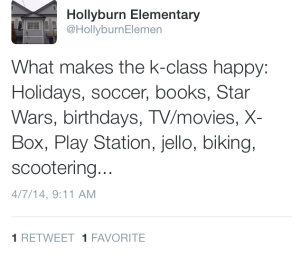This past weekend I participated in my first virtual conference. The Discovery Education Spring Virtual Conference was a free professional learning event for educators. Of course, virtual conferences are nothing new, they happen in many professions and there are numerous opportunities like the Global Education Conference and the Learning Revolution Conference. They are still new for many educators and, while I had heard of these events before, this was new learning for me.
A collection of observations:
- It was the first time that I gave a keynote presentation from my dining room table. It was wonderfully convenient but I also felt quite disconnected. Trying to passionately share my material speaking into my computer without any feedback from a live audience was challenging.
- The technology is good, but not perfect. Livestream, which hosted all of the presentations worked well, but there were some hiccups during the day making logging-in challenging. I also owe a huge thanks to Steve Dembo who assisted with setting me up for my presentation and was troubleshooting before and during the event. I found myself far more stressed about the technology than the content for the presentation.
- I was first up in the morning (6:00 a.m. on the west coast) and did ‘attend’ a variety of sessions throughout the day. I liked being able to start in one and if it wasn’t quite for me to leave and find another that was. There were a number of concurrent, live sessions participants could choose from at the event.
- I found that even though the sessions are archived immediately, I do like to see the live presentation. There is something about the shared experience of people, even if not face-to-face, all participating at the same time.
- The social elements make these events very powerful. Through an online chat on the host website, Facebook, Instagram and Twitter, there were amazingly rich conversations and sharing throughout the sessions. It was great to be able to connect over the #DENVirtCon hashtag.
- While it was somewhat of a lonely experience for me, I think part of the power of the event for many participants was the ability to conference across schools, districts, communities and North America to learn and engage with educators, and taking what they were learning online and processing it face-to-face. There were sessions being hosted in many locations. I think finding a way to make the online experience a blended experience (a mix of online and face-to-face) is key in making online learning experiences “sticky”.
And some conclusions:
- There are definitely some new models interfacing with professional learning. From Edcamps to TEDx events, to online conferences, these events are challenging the traditional conference format. I actually don’t know how long the traditional conference can survive. There is a place for events built on networking and connections, but those built around expert presentations where educators spend hundreds of dollars to sit in a large hotel events room may find it difficult to survive.
- I am blown away by how many passionate teachers will give up a Saturday for their own learning. I saw it this past weekend, also at EdCamp and a variety of other events.
- DENVirtCon featured presentations from across North America and largely, we are trying to do similar things. This may be a sweeping generalization, but the efforts we are making and the system we are aspiring to does appear to be similar in many areas — particularly, with an uber-engaged group of educators.
- I found DENVirtCon to be inspiring and I learned some things I can use this week — can’t ask for much more!
Here is a link to a video archive of my presentation and below are my slides:






